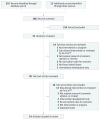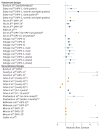Practice- and Community-Based Interventions to Increase Human Papillomavirus Vaccine Coverage: A Systematic Review
- PMID: 26010507
- PMCID: PMC4862306
- DOI: 10.1001/jamapediatrics.2015.0310
Practice- and Community-Based Interventions to Increase Human Papillomavirus Vaccine Coverage: A Systematic Review
Abstract
Importance: Vaccines against human papillomavirus (HPV) are recommended for routine use in adolescents aged 11 to 12 years in the United States, but uptake remains suboptimal. Educational interventions focused on parents and patients to increase coverage have not generally demonstrated effectiveness.
Objective: To systematically review the literature on effectiveness of interventions conducted at the practice or community level to increase uptake of HPV vaccines in the United States.
Evidence review: Keyword searches of the PubMed, Web of Science, and MEDLINE databases identified studies of adolescents that included the outcome of HPV vaccination published through July 2014. References of identified articles were also reviewed. A total of 366 records were screened, 38 full-text articles were reviewed, and 14 published studies were included. Results were summarized by different intervention approaches.
Findings: Practice- and community-based intervention approaches included reminder and recall (n = 7), physician-focused interventions (eg, audit and feedback) (n = 6), school-based programs (n = 2), and social marketing (n = 2) (2 interventions tested multiple approaches). Seven studies used a randomized design, and 8 used quasiexperimental approaches (one used both). Thirteen studies included girls, and 2 studies included boys. Studies were conducted in a variety of populations and geographic locations. Twelve studies reported significant increases in at least one HPV vaccination outcome, one reported a nonsignificant increase, and one reported mixed effects.
Conclusions and relevance: Most practice- and community-based interventions significantly increased HPV vaccination rates using varied approaches across diverse populations. This finding is in stark contrast to a recent review that did not find effects to warrant widespread implementation for any educational intervention. To address the current suboptimal rates of HPV vaccination in the United States, future efforts should focus on programs that can be implemented within health care settings, such as reminder and recall strategies and physician-focused efforts, as well as the use of alternative community-based locations, such as schools.
Conflict of interest statement
Figures


Similar articles
-
Evaluating the impact of multilevel evidence-based implementation strategies to enhance provider recommendation on human papillomavirus vaccination rates among an empaneled primary care patient population: a study protocol for a stepped-wedge cluster randomized trial.Implement Sci. 2018 Jul 13;13(1):96. doi: 10.1186/s13012-018-0778-x. Implement Sci. 2018. PMID: 30001723 Free PMC article. Clinical Trial.
-
Interventions to increase HPV vaccination coverage: A systematic review.Hum Vaccin Immunother. 2016 Jun 2;12(6):1566-88. doi: 10.1080/21645515.2015.1125055. Epub 2016 Feb 2. Hum Vaccin Immunother. 2016. PMID: 26838959 Free PMC article. Review.
-
Human Papillomavirus Vaccine Uptake: Increase for American Indian Adolescents, 2013-2015.Am J Prev Med. 2017 Aug;53(2):162-168. doi: 10.1016/j.amepre.2017.01.024. Epub 2017 Feb 28. Am J Prev Med. 2017. PMID: 28256284 Free PMC article.
-
Strategies to improve human papillomavirus vaccination rates among adolescents in family practice settings in the United States: A systematic review.J Clin Nurs. 2021 Feb;30(3-4):341-356. doi: 10.1111/jocn.15579. Epub 2020 Dec 16. J Clin Nurs. 2021. PMID: 33270305
-
Educational interventions to increase HPV vaccination acceptance: a systematic review.Vaccine. 2014 Apr 7;32(17):1901-20. doi: 10.1016/j.vaccine.2014.01.091. Epub 2014 Feb 14. Vaccine. 2014. PMID: 24530401 Free PMC article. Review.
Cited by
-
HPV infection and vaccination: a cross-sectional study of knowledge, perception, and attitude to vaccine uptake among university students in Qatar.BMC Public Health. 2024 Aug 26;24(1):2316. doi: 10.1186/s12889-024-19792-0. BMC Public Health. 2024. PMID: 39187821 Free PMC article.
-
Understanding the Factors Influencing Health Care Provider Recommendations about Adolescent Vaccines: A Proposed Framework.J Behav Med. 2023 Apr;46(1-2):356-365. doi: 10.1007/s10865-022-00296-4. Epub 2022 Feb 22. J Behav Med. 2023. PMID: 35194726 Free PMC article.
-
Trends in Precancerous Cervical Lesions by Area-Based Measures of Poverty, Race, and Ethnicity, Connecticut, 2008-2018.Public Health Rep. 2022 Nov-Dec;137(6):1146-1152. doi: 10.1177/00333549211056300. Epub 2021 Nov 2. Public Health Rep. 2022. PMID: 34727517 Free PMC article.
-
Using the 4 Pillars™ Practice Transformation Program to increase adolescent human papillomavirus, meningococcal, tetanus-diphtheria-pertussis and influenza vaccination.Vaccine. 2017 Oct 27;35(45):6180-6186. doi: 10.1016/j.vaccine.2017.09.039. Epub 2017 Sep 22. Vaccine. 2017. PMID: 28947346 Free PMC article. Clinical Trial.
-
Using an Implementation Research Framework to Identify Potential Facilitators and Barriers of an Intervention to Increase HPV Vaccine Uptake.J Public Health Manag Pract. 2017 May/Jun;23(3):e1-e9. doi: 10.1097/PHH.0000000000000367. J Public Health Manag Pract. 2017. PMID: 27902559 Free PMC article.
References
-
- Satterwhite CL, Torrone E, Meites E, et al. Sexually transmitted infections among US women and men: prevalence and incidence estimates, 2008. Sex Transm Dis. 2013;40(3):187–193. - PubMed
-
- Syrjänen K, Hakama M, Saarikoski S, et al. Prevalence, incidence, and estimated life-time risk of cervical human papillomavirus infections in a nonselected Finnish female population. Sex Transm Dis. 1990;17(1):15–19. - PubMed
-
- Winer RL, Lee SK, Hughes JP, Adam DE, Kiviat NB, Koutsky LA. Genital human papillomavirus infection: incidence and risk factors in a cohort of female university students. Am J Epidemiol. 2003;157(3):218–226. - PubMed
-
- Dunne EF, Unger ER, Sternberg M, et al. Prevalence of HPV infection among females in the United States. JAMA. 2007;297(8):813–819. - PubMed
-
- Manhart LE, Holmes KK, Koutsky LA, et al. Human papillomavirus infection among sexually active young women in the United States: Implications for developing a vaccination strategy. Sex Transm Dis. 2006;33(8):502–508. - PubMed
Publication types
MeSH terms
Substances
Grants and funding
LinkOut - more resources
Full Text Sources
Other Literature Sources
Medical

